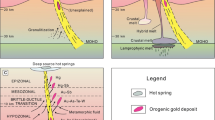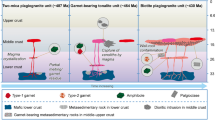Abstract
The Kennady North Project kimberlites (Northwest Territories of Canada) comprises multiple shallow dipping dykes and several volcaniclastic bodies that have an unusual shallow plunging geometry and complex “pipe” shapes that are termed chonoliths. The detailed exploration of the entire system provides exceptional evidence for subterranean volcanic conduit growth processes. The possible processes leading to the development of the kimberlite bodies are discussed, with emphasis on the importance of the subsurface intrusive system geometry and the local stress tensor. Emplacement into a locally compressive stress regime (i.e. σ1 and σ2 inclined at a low angle to surface) could change the kimberlite emplacement geometries to that observed at Kennady North. Models are proposed for the development of the chonoliths, to emphasize aspects of the growth of kimberlite systems that are not well understood. The conclusions challenge or evolve current emplacement models and should influence kimberlite exploration and resource definition assumptions.











Similar content being viewed by others
References
Agashev AM, Pokhilenko NP, Takazawa E, McDonald JA, Vavilov MA, Watanabe T, Sobolev NV (2008) Primary melting sequence of a deep (> 250 km) lithospheric mantle as recorded in the geochemistry of kimberlite–carbonatite assemblages, Snap Lake dyke system, Canada. Chem Geol 255(3):317–328
Anderson OL (1979) The role of fracture dynamics in kimberlite pipe formation. In: Meyer HOA, Boyd FR (eds) Kimberlites, diatremes, and diamonds: their geology, petrology and geochemistry. Proceedings of the 2nd International Kimberlite Conference, American Geophysical Union, pp 344–353
Aurora Geosciences (2016) Project exploration update and maiden mineral resource estimate, Kennady North Project, Northwest Territories, Canada. Technical Report 43–101, prepared on behalf of Kennady Diamonds Inc
Barnes SJ, Cruden AR, Arndt N, Saumur BM (2016) The mineral system approach applied to magmatic Ni–Cu–PGE sulphide deposits. Ore Geol Rev 76:296–316
Barnett W, Kurszlaukis S, Tait M, Dirks P (2011) Kimberlite wall-rock fragmentation processes: Venetia K08 pipe development. B Volcanol 73(8):941–958
Barnett W, Jelsma H, Watkeys M, Freeman L, Bloem A (2013) How structure and stress influence kimberlite emplacement. In: Pearson DG, Grütter HS, Harris JW, Kjarsgaard BA, O’Brien H, Rao NC, Sparks S (eds) Proceedings of 10th International Kimberlite Conference. Springer, New Delhi, pp 51–65
Bezzola M, Hetman C, Garlick G, Creaser R, Hrkac C, Vivian G, Diering M, Nowicki T (2017) Geology and resource development of the Kelvin kimberlite pipe, NWT, Canada. Proceedings of the 11th International Kimberlite Conference, abstract 11IKC-4643
Clement CR (1982) A comparative geological study of some major kimberlite pipes in the Northern Cape and Orange Free State. Dissertation, 2 volumes, University of Cape Town, IXX+432 + 406 pp
Clemente CS, Amorós EB, Crespo MG (2007) Dike intrusion under shear stress: effects on magnetic and vesicle fabrics in dikes from rift zones of Tenerife (Canary Islands). J Struct Geol 29(12):1931–1942
Cowan EJ, Beatson RK, Fright WR, McLennan TJ, Mitchell TJ (2002) Rapid geological modelling. Extended abstracts for applied structural geology for mineral exploration and mining. International Symposium, Kalgoorlie, Western Australia, pp. 23–25
Daly RA (1914) Igneous rocks and their origin. McGraw-Hill Book Company Inc., 563 pp
Delaney PT, Pollard DD, Ziony JI, McKee EH (1986) Field relationships between dikes and joints: emplacement process and palaeostress analysis. J Geophys Res 91:4920–4938
Doyle BJ, Kivi K, Scott Smith BH (1999) The Tli Kwi Cho (D027 and D018) diamondiferous kimberlite complex, Northwest Territories, Canada. In: Gurney JJ, Richardson SR (eds) Proceedings of the 7th International Kimberlite Conference, Cape Town, pp 194–204
Field M, Scott-Smith BH (1999) Contrasting geology and near-surface emplacement of kimberlite pipes in southern Africa and Canada. In: Gurney JJ, Richardson SR (eds) Proceedings of the 7th International Kimberlite Conference. Cape Town, pp 214–237
Field M, Stiefenhofer J, Robey J, Kurszlaukis S (2008) Kimberlite-hosted diamond deposits of southern Africa: a review. Ore Geol Rev 34(1–2):33–75
Fisher RV (1960) Classification of volcanic breccias. Geol Soc Am Bull 71(7):973–982
Gainer D, Hetman C, Diering M (2017) The geology of the Faraday 3 kimberlite, Kennady Lake, NWT Canada. Extended abstracts of the 11th International Kimberlite Conference, Gaborone, abstract 11IKC-4586
Gernon T, Field M, Sparks R (2012) Geology of the Snap Lake kimberlite intrusion, NW Territories, Canada: field observations and their interpretation. J Geol Soc Lond 169:1–16
Glazner AF, Bartley JM (2006) Is stoping a volumetrically significant pluton emplacement process? Geol Soc Am Bull 118(9–10):1185–1195
Gudmundsson A (2002) Emplacement and arrest of sheets and dykes in central volcanoes. J Volcanol Geoth Res 116:279–298
Harder M, Nowicki TE, Hetman CM, Freeman L, Abedu B (2013) Geology and evaluation of the K2 kimberlite, Koidu Mine, Sierra Leone, West Africa. In: Pearson DG, Grütter HS, Harris JW, Kjarsgaard BA, O’Brien H, Rao NC, Sparks S (eds) Proceedings of 10th International Kimberlite Conference. Springer, New Delhi, pp 191–208
Heaman LM, Kjarsgaard BA, Creaser RA (2003) The timing of kimberlite magmatism and implications for diamond exploration: a global perspective. Lithos 71:153–184
Helgeson HC, Kirkham DH, Flowers GC (1974) Theoretical prediction of the thermodynamic behavior of aqueous electrolytes at high pressures and temperatures I: summary of the thermodynamic / electrostatic properties of the solvent. Am J Sci 274:1089–1198
Helmstaedt HH, Pehrsson SJ (2012) Geology and tectonic evolution of the Slave Province – a post- Lithoprobe perspective. In: Percival JA, Cook FA, Clowes RM (eds) Tectonic styles in Canada: the lithoprobe perspective. Geological Association of Canada, Special Paper 49, pp 379–466
Hetman CM, Smith BS, Paul JL, Winter F (2004) Geology of the Gahcho Kue kimberlite pipes, NWT, Canada: root to diatreme magmatic transition zones. Lithos 76(1):51–74
Johnson JW, Norton D (1991) Critical phenomena in hydrothermal systems: state, thermodynamic, electrostatic, and transport properties of H2O in the critical region. Am J Sci 291:541–648
Kattenhorn SA, Watkeys MK (1995) Blunt-ended dyke segments. J Struct Geol 17(11):1535–1542
Kavanagh JL, Sparks RSJ (2011) Insights of dyke emplacement mechanics from detailed 3D dyke thickness datasets. J Geol Soc Lond 168(4):965–978
Lister JR, Kerr RC (1991) Fluid-mechanical models of crack propagation and their application to magma transport in dykes. J Geophys Res 96(B6):10049–10077
Lorenz V (1975) Formation of phreatomagmatic maar–diatreme volcanoes and its relevance to kimberlite diatremes. Phys Chem Earth 9:17–27
Lorenz V, Kurszlaukis S (2007) Root zone processes in the phreatomagmatic pipe emplacement model and consequences for the evolution of maar–diatreme volcanoes. J Volcanol Geoth Res 159(1–3):4–32
Mandl G (2005) Rock joints: the mechanical genesis. Springer, Berlin Heidelberg, p 221
Molyneux SJ, Hutton DHW (2000) Evidence for significant granite space creation by the ballooning mechanism: the example of the Ardara pluton, Ireland. Geol Soc Am Bull 112(10):1543–1558
Mort K, Woodcock NH (2008) Quantifying fault breccia geometry: Dent fault, NW England. J Struct Geol 30(6):701–709
Nakamura K (1977) Volcanoes as possible indicators of tectonic stress orientation – principal and proposal. J Volcanol Geoth Res 2:1–16
Nelson L, Hetman C, Diering M (2017a) The geology of the Faraday 1 kimberlite, NWT, Canada. Extended abstracts of the 11th International Kimberlite Conference, Gaborone, abstract 11IKC-4613
Nelson L, Hetman C, Diering M (2017b) The geology of the Faraday 2 kimberlite, NWT, Canada. Extended abstracts of the 11th International Kimberlite Conference, Gaborone, abstract 11IKC-4678
Nicholson R, Pollard DD (1985) Dilation and linkage of echelon cracks. J Struct Geol 7(5):583–590
Norton D, Dutrow B (2001) Complex behavior of magma-hydrothermal processes: role of supercritical fluid. Geochim Cosmochim Acta 65:4009–4018
Paterson SR, Fowler TK (1993) Re-examining pluton emplacement processes. J Struct Geol 15(2):191–206
Patterson M, Francis D, McCandless T (2009) Kimberlites: magmas or mixtures? Lithos 112S:191–200
Pollard DD (1973) Derivation and evaluation of a mechanical model for sheet intrusions. Tectonophysics 19:233–269
Pollard DD (1987) Elementary fracture mechanics applied to the structural interpretation of dykes. In: Hall HC, Fahrig WF (eds) Mafic dyke swarms. Geological Association of Canada, Special Paper 34, pp 5–24
Rubin AM (1995) Propagation of magma-filled cracks. Annu Rev Earth Pl Sc 23:287–336
Russell JK, Porritt LA, Lavallee Y, Dingwell DB (2012) Kimberlite ascent by assimilation-fuelled buoyancy. Nature 481:252–256
Scott Smith B, Nowicki TE, Russell JK, Webb KJ, Mitchell RH, Hetman CM, Harder M, Skinner EMW, Robey JA (2013) Kimberlite terminology and classification. In: Pearson DG, Grütter HS, Harris JW, Kjarsgaard BA, O’Brien H, Rao NC, Sparks S (eds) Proceedings of 10th International Kimberlite Conference. Springer, New Delhi, pp 1–17
Skinner EMW, Marsh JS (2004) Distinct kimberlite pipe classes with contrasting eruption processes. Lithos 76:183–200
Sparks RS, Baker L, Brown RJ, Field M, Schumacher J, Stripp G, Walters A (2006) Dynamical constraints on kimberlite volcanism. J Volcanol Geoth Res 155(1–2):18–48
Stamm N, Schmidt MW (2017) Asthenospheric kimberlites: volatile contents and bulk compositions at 7 GPa. Earth Planet Sc Lett 474:309–321
Stephenson PR, Vann J (2001) Common sense and good communication in mineral resource and ore reserve estimation. In: Edwards AC (ed) Mineral resource and ore reserve estimation - the AusIMM guide to good practice. Australian Institute of Mining and Metallurgy, Melbourne, pp 13–20
Stubley MP (2005) Slave craton: interpretive bedrock compilation. Northwest Territories Geological Survey, NWT-NU Open File 2005–01
Stubley MP (2015) Bedrock hosts to the kelvin-faraday, MZ, and Doyle kimberlite bodies southeastern Slave Craton (NTS 075N). Internal report prepared for Kennady Diamonds and Aurora Geosciences Ltd., 45 pp
Tappert R, Tappert MC (2017) Novel kimberlite exploration tools: delineating country rock hydration associated with kimberlites using VIS-SWIR hyperspectral point data collected from drill core. Abstracts of the 2017 Yellowknife Geoscience Forum, pp 78–79
White JL, Sparks RSJ, Bailey K, Barnett WP, Field M, Windsor L (2012) Kimberlite sills and dykes associated with the Wesselton kimberlite pipe, Kimberley, South Africa. S Afr J Geol 115(1):1–32
Wilson L, Head JW III (2007) An integrated model of kimberlite ascent and eruption. Nature 447:53–57
Acknowledgements
The authors would like to acknowledge the organizational committee of the 11 IKC for an exceptional conference and the opportunity to submit this manuscript. The gracious support and many detailed and thoughtful recommendations from Bruce Kjarsgaard, was greatly appreciated. The reviewers, Herb Helmstaedt and Eric de Kemp, are also thanked for their reviews that helped improve the message. Janine Kavanagh is thanked for pointing us towards the term “chonolith”.
Author information
Authors and Affiliations
Corresponding author
Additional information
Editorial handling: B. Kjarsgaard
Electronic supplementary material
Fig. S1
(PDF 144 kb)
Rights and permissions
About this article
Cite this article
Barnett, W., Stubley, M., Hetman, C. et al. Kelvin and Faraday kimberlite emplacement geometries and implications for subterranean magmatic processes. Miner Petrol 112 (Suppl 2), 447–462 (2018). https://doi.org/10.1007/s00710-018-0621-8
Received:
Accepted:
Published:
Issue Date:
DOI: https://doi.org/10.1007/s00710-018-0621-8




